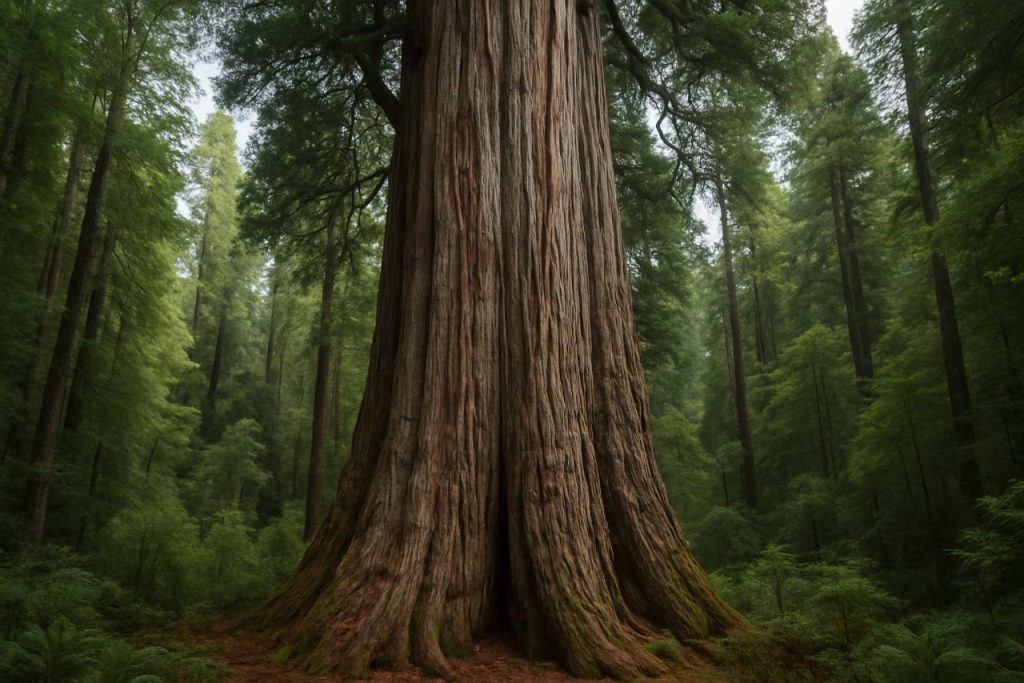
Unveiling Fitzroya Cupressoides: South America’s Timeless Redwood and Its Ecological Legacy. Discover the Secrets of the World’s Oldest Living Trees and Their Role in Biodiversity.
- Introduction to Fitzroya Cupressoides
- Taxonomy and Botanical Characteristics
- Geographic Distribution and Habitat
- Historical and Cultural Significance
- Longevity and Record-Breaking Age
- Ecological Role in Patagonian Forests
- Conservation Status and Threats
- Genetic Diversity and Adaptations
- Restoration and Sustainable Management
- Future Prospects and Research Directions
- Sources & References
Introduction to Fitzroya Cupressoides
Fitzroya cupressoides, commonly known as Alerce, is a towering evergreen conifer native to the temperate rainforests of southern Chile and Argentina. This remarkable tree is the sole species in the genus Fitzroya, belonging to the family Cupressaceae. Renowned for its impressive longevity and size, Fitzroya cupressoides is among the oldest living tree species on Earth, with some individuals estimated to be over 3,600 years old. The species was named in honor of Robert FitzRoy, the British naval officer and scientist who captained HMS Beagle during Charles Darwin’s famous voyage.
Alerce trees are characterized by their straight, columnar trunks, reddish-brown bark, and scale-like leaves arranged in whorls of three. Mature specimens can reach heights exceeding 60 meters, with trunk diameters surpassing 4 meters. The wood of Fitzroya cupressoides is highly valued for its durability, resistance to decay, and fine grain, historically making it a preferred material for construction and carpentry in southern South America.
Ecologically, Fitzroya cupressoides plays a crucial role in the Valdivian temperate rainforests, providing habitat and stability to a unique and biodiverse ecosystem. The species is adapted to the cool, humid climate of the Andean foothills, thriving in nutrient-poor soils and often forming pure or mixed stands with other native trees. Its slow growth and longevity contribute to the structural complexity and resilience of these ancient forests.
Despite its ecological and cultural significance, Fitzroya cupressoides has faced severe threats from overexploitation, land conversion, and fire. Extensive logging during the 19th and 20th centuries led to dramatic population declines, prompting conservation measures and legal protection in both Chile and Argentina. Today, the species is classified as Endangered on the IUCN Red List, and its remaining populations are primarily found within protected areas such as national parks and reserves. Conservation efforts are coordinated by governmental agencies, research institutions, and international organizations, including the International Union for Conservation of Nature (IUCN) and national environmental authorities in Chile and Argentina.
The enduring presence of Fitzroya cupressoides in the southern Andes stands as a testament to the resilience of ancient forests and underscores the importance of ongoing conservation initiatives to safeguard this living natural heritage for future generations.
Taxonomy and Botanical Characteristics
Fitzroya cupressoides, commonly known as Alerce, is a remarkable coniferous tree native to the temperate rainforests of southern Chile and Argentina. It belongs to the family Cupressaceae, which includes other well-known genera such as Cupressus (cypresses) and Sequoia (redwoods). The genus Fitzroya is monotypic, containing only this single species, which underscores its unique evolutionary lineage within the conifer group.
Taxonomically, Fitzroya cupressoides was first described by Charles Darwin and later named in honor of Robert FitzRoy, the captain of HMS Beagle. Its classification is as follows: Kingdom Plantae, Division Pinophyta, Class Pinopsida, Order Pinales, Family Cupressaceae, Genus Fitzroya, Species F. cupressoides. The species is sometimes referred to as “Patagonian cypress” due to its superficial resemblance to true cypresses, though it is genetically distinct.
Botanically, Fitzroya cupressoides is characterized by its impressive size and longevity. Mature individuals can reach heights of 40 to 60 meters, with trunk diameters exceeding 4 meters in exceptional cases. The bark is thick, fibrous, and reddish-brown, providing protection against fire and pests. The leaves are small, scale-like, and arranged in whorls of three, a distinguishing feature among Cupressaceae members. The reproductive structures are also notable: male cones are small and inconspicuous, while female cones are globular, woody, and contain several winged seeds that facilitate wind dispersal.
One of the most remarkable botanical characteristics of Fitzroya cupressoides is its extreme longevity. Some individuals have been dated to over 3,600 years old, making them among the oldest living trees on Earth. This longevity is attributed to slow growth rates, dense wood, and resistance to decay. The wood itself is highly valued for its durability and resistance to rot, historically leading to extensive logging and subsequent conservation concerns.
The species is endemic to the Valdivian temperate rainforests, thriving in cool, moist environments with high rainfall and acidic soils. Its ecological role is significant, providing habitat and stabilizing soils in its native range. Due to its unique taxonomic status and ecological importance, Fitzroya cupressoides is protected under various conservation frameworks, including listings by the International Union for Conservation of Nature (IUCN).
Geographic Distribution and Habitat
Fitzroya cupressoides, commonly known as Alerce, is a coniferous tree species native to the temperate rainforests of southern South America. Its geographic distribution is highly restricted, primarily spanning the Andes and coastal ranges of southern Chile and adjacent areas of Argentina. The species is found between latitudes 39°30′S and 43°30′S, with the majority of populations concentrated in the Los Lagos and Los Ríos regions of Chile, and a few isolated stands in the Argentine provinces of Neuquén and Chubut.
The natural habitat of Fitzroya cupressoides is characterized by cool, humid climates with high annual rainfall, often exceeding 2,000 mm. These trees typically grow at elevations ranging from sea level up to 1,500 meters, thriving in poorly drained soils such as peat bogs, waterlogged valleys, and slopes with high moisture retention. The species is a dominant component of the Valdivian temperate rainforest, an ecosystem recognized for its exceptional biodiversity and endemism. Within these forests, Fitzroya cupressoides often forms pure or mixed stands, coexisting with other native species such as Nothofagus dombeyi and Drimys winteri.
The distribution of Fitzroya cupressoides has been significantly reduced due to historical logging, land conversion, and fire. Today, many of the remaining populations are found within protected areas, including national parks and reserves, which are managed by organizations such as the Corporación Nacional Forestal (CONAF) in Chile. These conservation efforts are crucial, as the species is classified as Endangered by the International Union for Conservation of Nature (IUCN), reflecting its limited range and ongoing threats.
In Argentina, Fitzroya cupressoides is primarily restricted to the Andean foothills, where it occupies similar ecological niches as in Chile. The species’ presence in both countries highlights the importance of transboundary conservation initiatives to ensure its long-term survival. The unique habitat requirements and fragmented distribution of Fitzroya cupressoides make it particularly vulnerable to climate change and human disturbance, underscoring the need for continued research and habitat protection by governmental and scientific organizations.
Historical and Cultural Significance
Fitzroya cupressoides, commonly known as Alerce, is a towering conifer native to the temperate rainforests of southern Chile and Argentina. Its historical and cultural significance is deeply rooted in the traditions and livelihoods of the indigenous Mapuche and Huilliche peoples, as well as in the colonial and modern history of southern South America. The tree’s remarkable longevity—some individuals are over 3,600 years old—has made it a symbol of endurance and continuity in the region.
For centuries, Fitzroya cupressoides played a central role in the daily life and spiritual beliefs of local communities. The Mapuche and Huilliche used its durable, rot-resistant wood for constructing homes, canoes, and tools. The wood’s value was so high that, during the colonial period, it became a form of currency known as “real de alerce,” facilitating trade throughout southern Chile. This economic importance persisted into the 19th and 20th centuries, when the exploitation of Fitzroya forests contributed significantly to the development of the region’s timber industry.
The cultural reverence for Fitzroya is also reflected in local folklore and oral traditions, where the tree is often associated with wisdom, protection, and the continuity of life. Its immense size and age have inspired awe and respect, leading to its designation as a national monument in Chile. The tree’s image is frequently used in regional emblems and is a source of pride for local communities.
However, the historical exploitation of Fitzroya cupressoides led to severe population declines, prompting conservation efforts in the late 20th century. Today, the species is protected under Chilean law and is listed as Endangered by the International Union for Conservation of Nature (IUCN). The Chilean government, through the Corporación Nacional Forestal (CONAF), manages several protected areas where Fitzroya forests are preserved, such as Alerce Andino and Alerce Costero National Parks. These efforts aim not only to conserve the species but also to maintain its cultural legacy for future generations.
In summary, Fitzroya cupressoides is more than a botanical marvel; it is a living testament to the intertwined natural and cultural history of southern South America. Its preservation is vital for maintaining both biodiversity and the cultural heritage of the region’s indigenous and local communities.
Longevity and Record-Breaking Age
Fitzroya cupressoides, commonly known as the Alerce, is renowned for its extraordinary longevity, ranking among the oldest living tree species on Earth. Native to the temperate rainforests of southern Chile and Argentina, this conifer can reach ages that rival or surpass those of the famous bristlecone pines of North America. Scientific studies have documented individual Fitzroya specimens exceeding 3,600 years in age, making them some of the oldest known non-clonal trees. The most celebrated example is the “Gran Abuelo” (Great-Grandfather) tree, located in Alerce Costero National Park, Chile, which has been estimated to be over 3,600 years old based on dendrochronological analysis.
The remarkable lifespan of Fitzroya cupressoides is attributed to several factors, including its slow growth rate, resistance to decay, and the stable, humid climate of its native habitat. The dense, resinous wood of the Alerce is highly resistant to fungal and insect attack, which contributes to its ability to persist for millennia. Additionally, the remote and often inaccessible locations where these trees grow have helped shield some populations from extensive human disturbance.
The longevity of Fitzroya cupressoides has significant ecological and scientific implications. These ancient trees serve as living archives of environmental history, with their annual growth rings providing valuable records of past climate conditions, volcanic eruptions, and other ecological events. Dendrochronologists—scientists who study tree rings—have used Fitzroya samples to reconstruct climate patterns in southern South America over thousands of years, offering insights into long-term environmental changes and aiding in the understanding of global climate dynamics.
The record-breaking age of Fitzroya cupressoides has also contributed to its cultural and conservation significance. The species is protected under Chilean law and is listed as Endangered by the International Union for Conservation of Nature (IUCN), due to historical overexploitation for its valuable timber and ongoing threats from habitat loss. Conservation efforts are supported by organizations such as the Chilean National Forest Corporation (CONAF), which manages protected areas where ancient Fitzroya trees are found. The preservation of these ancient giants is not only vital for biodiversity but also for maintaining the unique natural heritage of the southern Andes.
Ecological Role in Patagonian Forests
Fitzroya cupressoides, commonly known as Alerce, is a keystone conifer species endemic to the temperate rainforests of southern Chile and Argentina. Its ecological role in Patagonian forests is profound, shaping both the structure and function of these unique ecosystems. As one of the longest-lived tree species in the world—some individuals are over 3,600 years old—Fitzroya cupressoides forms ancient stands that provide critical habitat and influence forest dynamics over millennia.
Alerce trees dominate the canopy in certain areas, creating dense, moist microclimates beneath their branches. This canopy cover regulates temperature and humidity, supporting a rich understory of mosses, ferns, and shade-tolerant plants. The thick, fibrous bark and towering trunks offer nesting and shelter opportunities for a variety of endemic birds, mammals, and invertebrates. Notably, the forests where Fitzroya cupressoides thrives are home to species such as the endangered Darwin’s fox (Lycalopex fulvipes) and the Magellanic woodpecker (Campephilus magellanicus), both of which rely on old-growth forest conditions for survival.
Fitzroya cupressoides also plays a vital role in hydrological regulation. Its extensive root systems stabilize soils on steep Andean slopes, reducing erosion and landslide risk. The species’ presence in watersheds helps maintain water quality and flow, as the forests act as natural sponges, absorbing rainfall and releasing it gradually into streams and rivers. This function is particularly important in the Valdivian temperate rainforest ecoregion, where high precipitation and steep terrain make erosion control essential for ecosystem health.
The slow growth and longevity of Fitzroya cupressoides contribute significantly to carbon sequestration. Old-growth Alerce forests store large amounts of carbon in both living biomass and accumulated organic matter, making them important carbon sinks in the fight against climate change. The conservation of these forests is thus a priority for both biodiversity and climate mitigation efforts. Organizations such as the Corporación Nacional Forestal (CONAF) in Chile are actively involved in the protection and management of Fitzroya cupressoides habitats, recognizing their irreplaceable ecological value.
In summary, Fitzroya cupressoides is a foundational species in Patagonian forests, underpinning biodiversity, stabilizing landscapes, regulating water cycles, and storing carbon. Its preservation is essential for maintaining the integrity and resilience of these ancient temperate ecosystems.
Conservation Status and Threats
Fitzroya cupressoides, commonly known as Alerce, is a coniferous tree native to the temperate rainforests of southern Chile and Argentina. Renowned for its exceptional longevity—some individuals are over 3,600 years old—Fitzroya cupressoides is a keystone species in its ecosystem. However, its conservation status is of significant concern. The International Union for Conservation of Nature (IUCN), a leading global authority on species conservation, currently lists Fitzroya cupressoides as Endangered on its Red List. This designation reflects the species’ high risk of extinction in the wild due to a combination of historical and ongoing threats.
The primary threat to Fitzroya cupressoides has been extensive logging, particularly during the 19th and 20th centuries. Its durable, rot-resistant wood was highly prized for construction and shipbuilding, leading to widespread exploitation and a dramatic reduction in mature populations. Although commercial logging is now prohibited in Chile and Argentina, illegal harvesting and selective cutting still occur, especially in remote areas. Habitat loss and fragmentation due to agricultural expansion, livestock grazing, and the development of infrastructure further exacerbate the species’ decline. Fires, both natural and human-induced, have also played a significant role in reducing Fitzroya forests, as the species is slow-growing and poorly adapted to recover from fire events.
Climate change poses an emerging threat to Fitzroya cupressoides. Altered precipitation patterns, increased frequency of droughts, and shifting temperature regimes may impact seedling establishment and forest regeneration. Additionally, the species’ limited distribution and fragmented populations make it particularly vulnerable to stochastic events and genetic bottlenecks.
Conservation efforts are underway to protect and restore Fitzroya cupressoides populations. The species is legally protected in both Chile and Argentina, and significant stands are found within national parks and reserves, such as Chile’s Corporación Nacional Forestal (CONAF) managed areas. Internationally, Fitzroya cupressoides is listed in Appendix I of the Convention on International Trade in Endangered Species of Wild Fauna and Flora (CITES), which prohibits international commercial trade of the species. Ongoing research, habitat restoration, and community engagement are critical components of current conservation strategies, aiming to ensure the long-term survival of this ancient and ecologically significant tree.
Genetic Diversity and Adaptations
Fitzroya cupressoides, commonly known as Alerce, is a long-lived conifer endemic to the temperate rainforests of southern Chile and Argentina. Its genetic diversity and adaptive traits are central to its survival in the face of environmental pressures, including climate change, habitat fragmentation, and historical exploitation. Understanding the genetic structure and adaptive mechanisms of Fitzroya is crucial for its conservation and management.
Genetic studies have revealed that Fitzroya cupressoides exhibits moderate to high levels of genetic diversity, particularly when compared to other long-lived conifers. This diversity is distributed both within and among populations, reflecting the species’ wide geographic range and the complex glacial history of southern South America. The genetic variation is thought to be shaped by historical events such as glaciations, which caused population bottlenecks and subsequent expansions, as well as by the species’ limited seed dispersal and clonal growth habits.
Adaptations in Fitzroya cupressoides are evident in its remarkable longevity—some individuals are known to be over 3,600 years old, making it one of the longest-lived tree species on Earth. This longevity is supported by physiological and anatomical traits such as dense, decay-resistant wood and a slow growth rate, which confer resilience to environmental stressors and pathogens. The species is also adapted to the high rainfall and acidic soils of the Valdivian temperate rainforest, with a root system capable of tolerating waterlogged conditions.
Despite its adaptive strengths, Fitzroya cupressoides faces significant threats from habitat loss, illegal logging, and climate change. Fragmentation of its habitat can reduce gene flow between populations, increasing the risk of inbreeding and loss of genetic diversity. Conservation efforts, therefore, focus on protecting existing populations, restoring degraded habitats, and maintaining genetic connectivity across its range. Organizations such as the International Union for Conservation of Nature (IUCN) have listed Fitzroya cupressoides as an endangered species, highlighting the urgent need for coordinated conservation strategies.
Recent advances in molecular genetics, including the use of microsatellite markers and genome sequencing, are providing new insights into the genetic structure and adaptive potential of Fitzroya cupressoides. These tools are essential for identifying genetically important populations and informing management decisions aimed at preserving the evolutionary potential of this iconic tree species.
Restoration and Sustainable Management
Fitzroya cupressoides, commonly known as Alerce, is a long-lived conifer native to the temperate rainforests of southern Chile and Argentina. Due to its exceptional longevity and slow growth, the species has faced significant threats from overexploitation, land conversion, and climate change. Restoration and sustainable management of Fitzroya cupressoides forests are critical for preserving biodiversity, maintaining ecosystem services, and supporting local communities.
Restoration efforts for Fitzroya cupressoides focus on both natural regeneration and active reforestation. Natural regeneration is often limited by factors such as seed predation, competition with invasive species, and altered fire regimes. As a result, active interventions—including the collection and sowing of seeds, nursery propagation, and the planting of seedlings—are frequently employed to accelerate recovery. These activities are typically guided by ecological principles to ensure genetic diversity and resilience of restored populations. Organizations such as the Corporación Nacional Forestal (CONAF) in Chile play a central role in coordinating restoration projects, enforcing legal protections, and monitoring forest health.
Sustainable management of Fitzroya cupressoides forests involves balancing conservation with the needs of local communities. Traditional uses of Alerce wood, prized for its durability and resistance to decay, have historically driven unsustainable harvesting. Today, Fitzroya cupressoides is listed under Appendix I of the Convention on International Trade in Endangered Species of Wild Fauna and Flora (CITES), which prohibits international commercial trade of wild-sourced timber. National regulations, such as those enforced by CONAF, further restrict logging and promote sustainable forest management practices, including selective harvesting, restoration of degraded areas, and the development of alternative livelihoods for local populations.
Community involvement is increasingly recognized as essential for the long-term success of restoration and sustainable management initiatives. Participatory approaches engage indigenous and rural communities in decision-making, benefit-sharing, and stewardship activities. These collaborations help integrate traditional ecological knowledge with scientific research, fostering adaptive management strategies that are culturally appropriate and ecologically effective.
Climate change poses additional challenges and opportunities for Fitzroya cupressoides conservation. Shifts in temperature and precipitation patterns may affect the species’ distribution and regeneration capacity. Ongoing research by academic institutions and conservation organizations aims to identify climate-resilient restoration techniques and to model future habitat suitability. The integration of climate adaptation into restoration planning is vital for ensuring the persistence of Fitzroya cupressoides forests in a changing environment.
Future Prospects and Research Directions
Fitzroya cupressoides, commonly known as Alerce, is a long-lived conifer native to the temperate rainforests of southern Chile and Argentina. As a keystone species with exceptional longevity—some individuals are over 3,600 years old—Fitzroya plays a critical ecological role in its native habitat. Looking ahead, the future prospects and research directions for Fitzroya cupressoides are shaped by both conservation imperatives and scientific opportunities.
One of the primary research directions involves understanding the species’ response to climate change. Fitzroya’s slow growth and sensitivity to environmental changes make it a valuable indicator for studying long-term climate patterns. Dendrochronological studies, which analyze tree rings, have already provided insights into past climate variability in the southern Andes. Future research is expected to focus on how ongoing shifts in temperature and precipitation may affect Fitzroya’s growth, regeneration, and distribution. This work is crucial for informing adaptive management strategies in the face of global climate change.
Conservation genetics is another promising area. Given the species’ fragmented distribution and history of overexploitation, genetic studies are needed to assess population structure, genetic diversity, and gene flow. Such research can guide restoration efforts and the design of protected areas, ensuring the long-term viability of Fitzroya populations. Advances in molecular techniques, such as genome sequencing, are likely to enhance our understanding of the species’ evolutionary history and adaptive potential.
Restoration ecology is also gaining momentum. Efforts to restore degraded Fitzroya forests require knowledge of seedling establishment, soil conditions, and interactions with other species. Research into propagation techniques, mycorrhizal associations, and the impacts of invasive species will be vital for successful reforestation projects. Collaboration with local communities and indigenous groups, who possess traditional knowledge about Fitzroya, is increasingly recognized as essential for effective conservation and restoration.
Finally, Fitzroya cupressoides is of interest for its role in carbon sequestration. As a slow-growing but long-lived tree, it stores significant amounts of carbon over millennia. Quantifying its carbon storage capacity and understanding its contribution to ecosystem services are important research priorities, especially in the context of climate mitigation policies.
Ongoing and future research on Fitzroya cupressoides is supported by organizations such as the Corporación Nacional Forestal (CONAF) in Chile, which manages protected areas and implements conservation programs, and international bodies like the International Union for Conservation of Nature (IUCN), which lists Fitzroya as a threatened species and provides guidance on its conservation status. These efforts, combined with advances in ecological and genetic research, will be critical for ensuring the survival and resilience of this iconic tree species.



